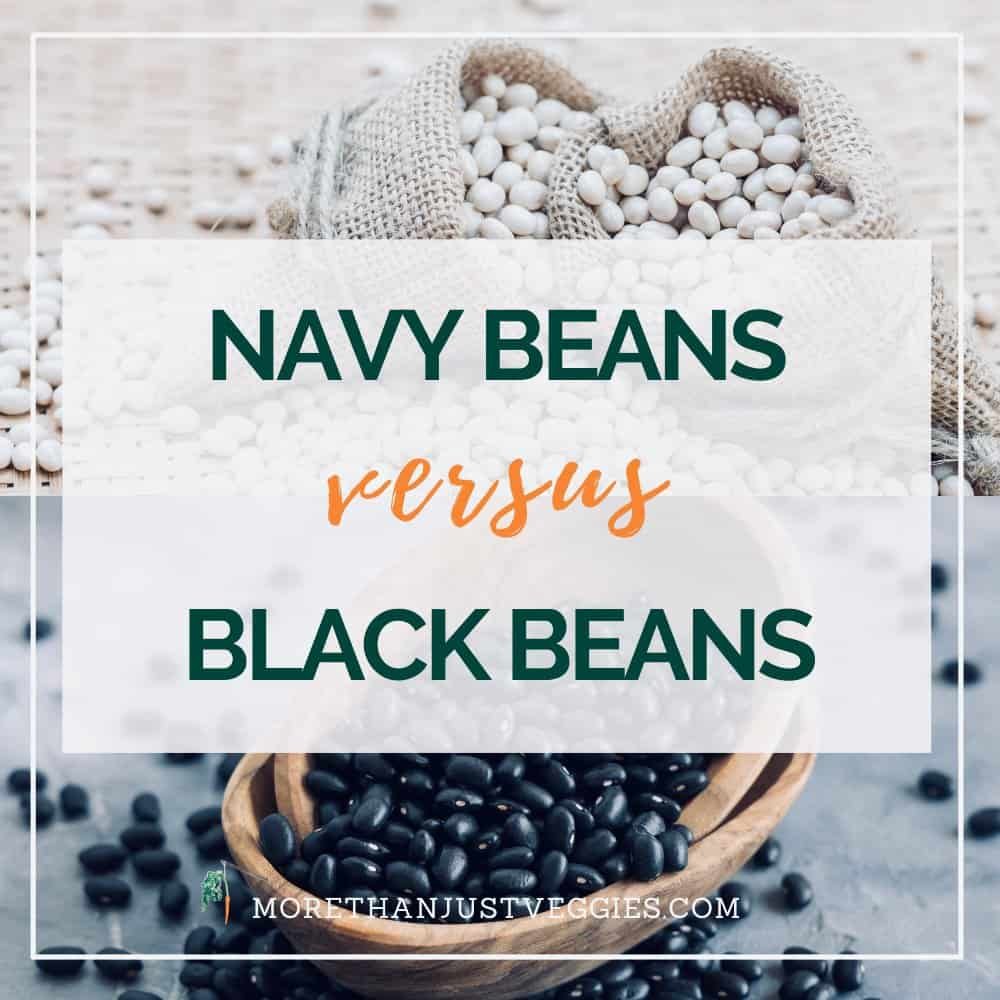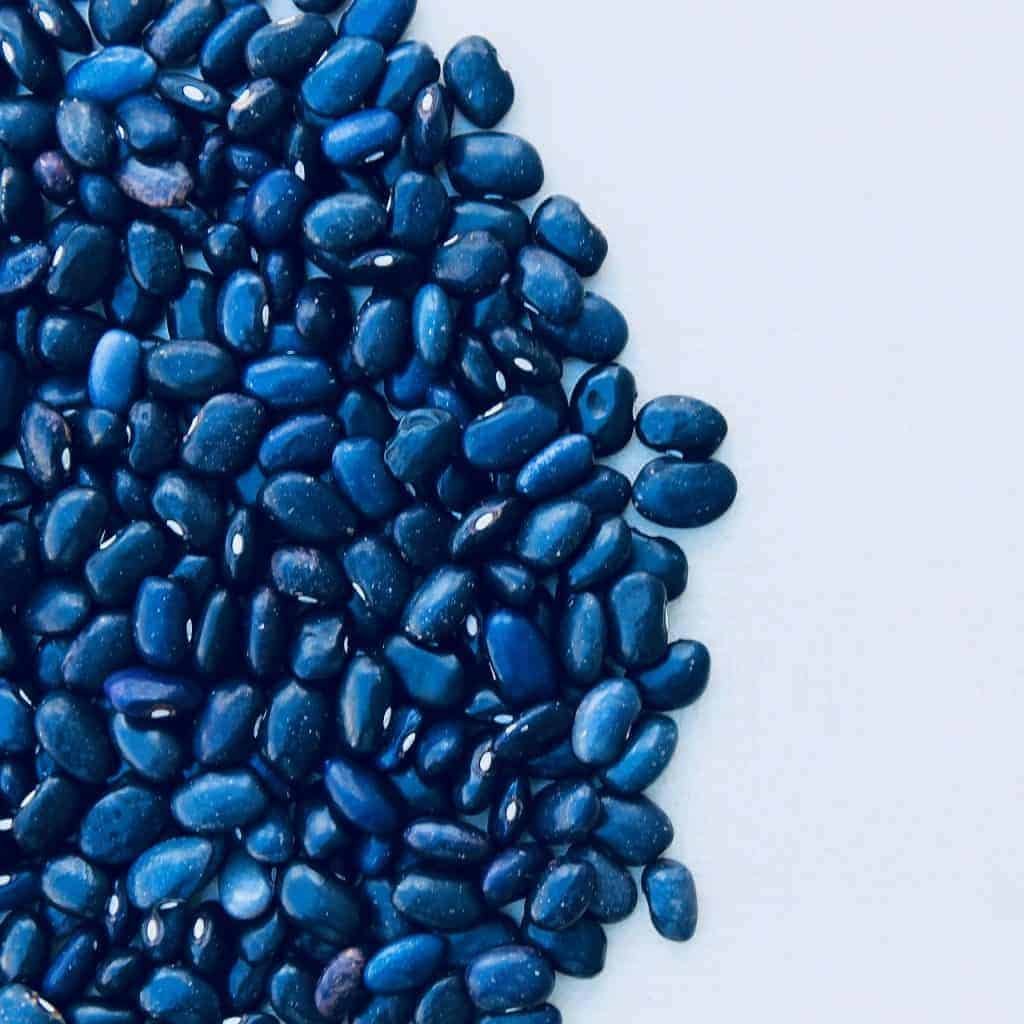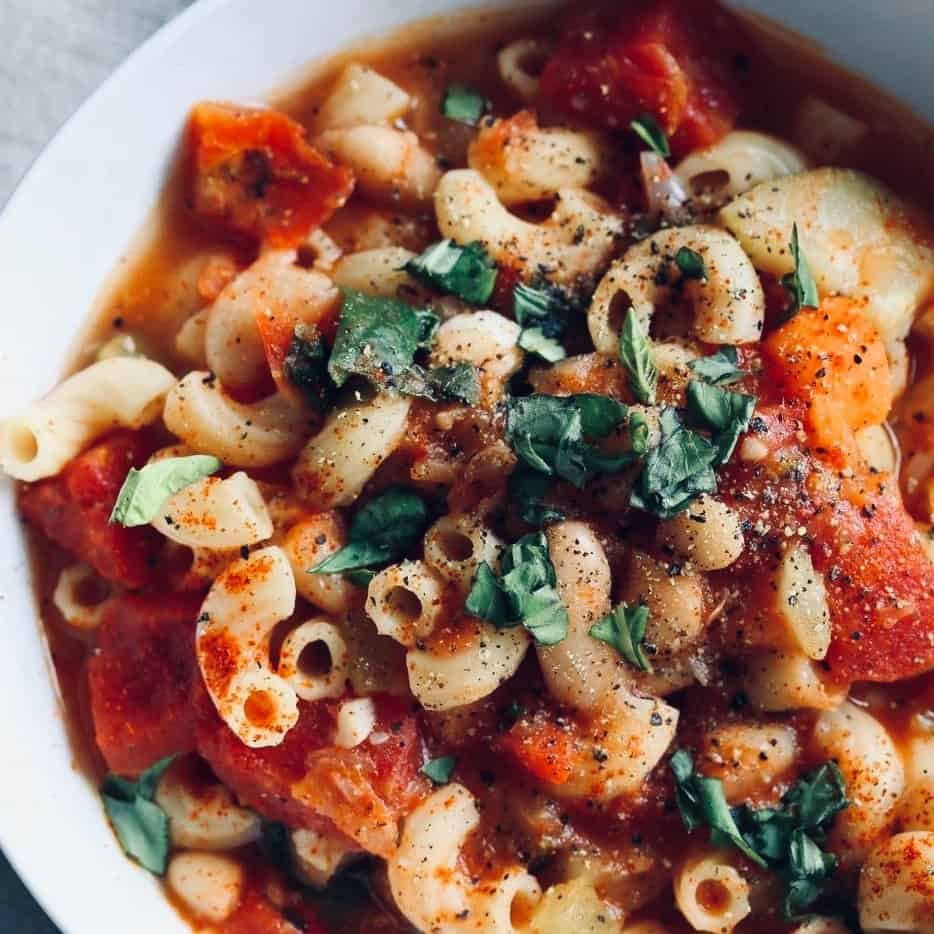Navy beans vs black beans; which is healthier?
Both have been a staple in cuisines around the world for centuries. They are cheap, tasty, and a sustainable diet choice.
But is one beter than the other? Read on for an in-depth comparison of their nutrient content, flavor profiles, and advice on how to decide between the two.
I’ve also included a few suggestions of tasty vegan navy bean and black bean recipes you may wish to try out.

Table of contents
- What are navy beans?
- What are black beans?
- Navy beans vs black beans: nutritional comparison
- Benefits of navy beans vs black beans
- Controversies about beans explained
- How to decide between the two
- Vegan navy bean recipes
- Vegan black bean recipes

What are navy beans?
Navy beans, also known as haricot beans, are a variety of beans native to the Americas. Don’t be fooled by their name. These beans aren’t navy, they’re actually creamy white!
In fact, you may easily confuse navy with other types of white beans such as cannellini beans, great northern beans or white kidney beans.
Similarly to these other white beans, navy beans are quite mild in flavor.
One key difference is that navy beans are typically smaller than these other types of white beans. They also have an oval, slightly flattened shape.
In sum: Navy beans are a small, round, type of white bean. They’re native to the American continent and mild in flavor.

What are black beans?
Black beans, further known as turtle beans, are also native to the Americas.
They are a medium-size, oval-shaped bean that is black on the outside, and creamy white on the inside.
Their slightly sweet flavor and soft texture make them a staple in Caribbean, Central- and South-American cuisine.
In sum: Black beans are also native to the Americas. They’re black on the outside, white on the inside, and are slightly sweet in flavor.

Navy beans vs black beans: nutritional composition
As you’ll see in the table below, both of these beans are incredibly nutritious.
Navy beans versus black beans nutrition comparison
| Navy beans (± ½ cup / 91 grams) | Black beans (± ½ cup / 86 grams) | |
| Calories | 127 kcal | 114 kcal |
| Carbs | 24 grams | 20 grams |
| Fiber | 10 grams | 8 grams |
| Fat | <1 gram | < 1 gram |
| Protein | 8 grams | 8 grams |
| Vitamin B1 (thiamine) | 43% of the daily value (DV) | 42% of the daily value (DV) |
| Vitamin B2 (riboflavin) | 12% of the DV | 10% of the DV |
| Vitamin B3 (niacin) | 10% of the DV | 7% of the DV |
| Vitamin B5 (pantothenic acid) | 12% of the DV | 10% of the DV |
| Vitamin B6 (pyridoxine) | 25% of the DV | 12% of the DV |
| Vitamin B12 (cobalamin) | 0% of the DV | 0% of the DV |
| Folate | 85% of the DV | 85% of the DV |
| Vitamin A | 0% of the DV | 1% of the DV |
| Vitamin C | 5% of the DV | 0% of the DV |
| Vitamin D | 0% of the DV | 0% of the DV |
| Vitamin E | 0% of the DV | 12% of the DV |
| Vitamin K | 2% of the DV | 9% of the DV |
| Calcium | 9% of the DV | 3% of the DV |
| Copper | 56% of the DV | 53% of the DV |
| Iron | 31% of the DV | 26% of the DV |
| Magnesium | 31% of the DV | 75% of the DV |
| Manganese | 40% of the DV | 32% of the DV |
| Phosphorus | 28% of the DV | 26% of the DV |
| Potassium | 12% of the DV | 10% of the DV |
| Selenium | 13% of the DV | 5% of the DV |
| Sodium | 0% of the DV | 0% of the DV |
| Zinc | 31% of the DV | 32% of the DV |
Nutrition differences between navy beans and black beans
The nutritional difference between navy beans vs black beans are very minimal.
Both provide 8 grams of plant protein per ½ cup serving.
The main difference is that navy beans are slightly higher in carbs and fiber. You’ll also notice that navy beans contain significantly more vitamin B6 and selenium, while black beans are richer in Vitamin E and magnesium.
In the context of a varied diet, these differences, although seemingly significant on paper, don’t actually matter all that much.
So all in all, both beans are pretty equal from a nutrition perspective.
In Sum: Both beans are pretty equivalent in terms of nutrition composition. They are both a good source of protein and fiber and their differences in vitamin and mineral composition are very slight.

Benefits of navy beans vs black beans
Both beans offer several health and planet benefits.
Health benefits of navy beans versus black beans
First, beans are part of a larger food category known as legumes.
Legumes as a category include beans, peas, and lentils. Each of these nutrient-dense foods are rich in protein, fiber, vitamins, minerals, antioxidants, and other beneficial plant compounds.
Legumes are also low in fat and contain no cholesterol, both of which are beneficial for the health of your heart. They also have a low glycemic index, meaning that they tend to keep blood sugar levels more constant (1).
Studies link legumes to various health benefits. These include an improved blood sugar control, a lower weight, and smaller waist circumference (1).
Legumes also appear to lower the likelihood of developing obesity, diabetes, cancer, and heart disease (1).
Including as little as 1 cup (± 190 grams) of legumes in your diet each day may be enough to reap these benefits (2).
What’s more, legumes appear to play a crucial role in the health of your gut and immune system. They also seemingly help extend the amount of healthy years you have to live (2, 3).
Environmental benefits of navy beans versus black beans
From a planet perspective, beans have the ability to fix nitrogen into the soil. This enhances the quality of the soil, which, in turn, reduces the need for synthetic fertilizers (4).
In addition to less fertilizer, they also require less water than most other crop types. They can also be grown in a variety of climates and soil types. This makes them a more sustainable option for farmers (4).
The plant-protein found in beans also has a lower carbon footprint than animal protein, which makes them a planet-friendly choice (4).
In sum: Both navy and black beans are linked to improved health and a lower likelihood of various diseases. They also appear to improve the health of your gut and immune system. Plus, they’re a very sustainable crop to grow for farmers.

Controversies about beans explained
There are many misconceptions about beans.
For instance, you may worry that beans may cause digestive issues. Or may have been told that beans contain incomplete proteins and antinutrients which are harmful to your health.
This can make you weary of adding them to your diet. So allow me to ease your mind by covering each of these controversies individually.
Beans contain antinutrients?
Antinutrients are plant compounds that can reduce your body’s ability to absorb the nutrients they contain.
The most widely studied antinutrients include phytic acid, tannins, lectins, protease inhibitors, and calcium oxalates.
There are a few things to keep in mind about antinutrients.
Studies have shown that they may make it more difficult for your body to absorb certain other nutrients. That said, antinutrients are very rarely ingested in their isolated format, as is the case in studies (5).
Plant-based diets naturally contain antinutrients in combination with thousands of other compounds, many of which naturally counteract their effects.
In addition, you can reduce the amount of antinutrients a food contains by sprouting, fermenting, soaking or cooking it.
So although antinutrients may seem harmful in isolation, they likely act differently when consumed within the context of whole plant foods that are fermented, soaked, or cooked (5).
Interestingly, recent research suggests that antinutrients may, in certain instances, actually lead to beneficial health effects (5).
From a big picture perspective, the evidence suggests that the many health benefits linked to a plant-based diet far outweigh the potential impact of antinutrients on reduced nutrient absorption.

Beans contain incomplete proteins?
Proteins are made up of chains of essential and non-essential amino acids.
The difference between the two is that your body can make non-essential amino acids. However, essential amino acids can only be harvested from your diet.
All foods contain varying amounts of all amino acids. However, some foods tend to contain higher amounts of essential amino acids than others.
Generally-speaking, plant foods tend to be low in one or two essential amino acids. Because of this, they are sometimes referred to as “incomplete” sources of protein.
However, in the context of a well-balanced plant-based diet, this should be a non-issue.
Beans tend to be low in the essential amino acids methionine and cysteine, but rich in lysine. On the other hand, grains tend to be low in lysine, but rich in methionine (6).
As long as your diet contains both grains and legumes, in equivalent amounts, you’re more than likely to consume all of the essential amino acids you’ll need (7).
Beans can cause digestive issues?
You may find that high-fiber foods, such as beans, can cause your gut to become distressed.
This often happens when you increase the fiber content of your diet too quickly. If this is the case for you, try increasing the amount of beans you consume little by little to see if it helps.
Soaking your beans prior to cooking and rinsing canned beans well before eating them can also help reduce digestive distress.
You may also experience digestive issues when eating beans if you have irritable bowel syndrome, diverticulitis, food intolerances, or inflammatory bowel disease.
If this is the case, you may need some more careful testing of your diet to determine which foods, and in which quantities, are causing the issue. Tailored guidance from a registered dietitian can help with this.
In sum: The antinutrients in beans are likely a non-issue in the context of eating whole plant foods. Eating both beans and grains will increase the protein quality of your plant-based diet. To reduce gut upset, increase their quantity gradually.

How to decide between the two
So you may wonder how to choose between navy and black beans. Here are a couple of criteria I personally keep in mind when picking between the two.
Flavor
Black beans tend to have a slightly sweet taste. They work well with many dishes, ranging from soups, to stews, to salads.
Navy beans have more of a neutral flavor. They’re my go-to when wanting to add a source of protein to soups or sauces without changing their flavor too much.
Type of dish
I tend to use black beans mostly in dishes that focus on them as the main ingredient. For instance, when making refried beans for tacos, burritos, chili, or black bean burger patties.
Navy beans are my go-to for adding an inconspicuous source of protein to dishes without changing their color. For instance, adding protein to a pumpkin soup, or to a white pasta sauce.
Digestibility
Some people may find one type of bean more easily digestible than the other. So this is a criteria you may want to keep in mind if your gut tends to be sensitive to beans.
In sum: When picking between navy and black beans, you may want to consider the flavor, and type of dish you’re seeking to create. If your gut is sensitive to beans, you may also want to consider which one is easiest to digest for you.
Vegan navy bean vs black bean recipes
The recipes below aim to provide you with some inspiration on interesting ways to use navy beans and black beans in your vegan recipes.
Vegan navy bean recipes

Vegan minestrone soup by Vegan Richa

Lemon tahini white bean Caesar salad by Best of Vegan

Sun-dried tomato white bean skillet with garlic bread by Plant-Based RD

Saucy beans on garlic toast by Pick up Limes

Lemon asparagus pasta by Rainbow Plant Life

Beet white bean hummus by Essy Cooks
Vegan black bean recipes

Vegan instant pot chili by Jessica in the Kitchen

Vegan black bean quinoa casserole by Veggies Save the Day

Mexican potato skins by Lazy Cat Kitchen

Vegan refried beans by Loving it Vegan

BBQ black bean burgers by Gaz Oakley

Savory polenta stacks with black bans, greens and mashed yams by The Full Helping
In sum: There is a wide array of recipes to pick from when trying to include navy beans or black beans in your plant-based meals. The selection above should give you some inspiration to get you started!
Other types of beans and when to use them
Black and navy beans are only two of many beans you can choose from when making plant-based meals.
The table below should help you out when trying to decide which bean to use for which dish.
| Type of bean | Flavor | Dish ideas | |
|---|---|---|---|
| Black beans | Sweet | Tacos, burritos, refried beans, chili, rice and beans, soups, salads. | |
| Cranberry beans (also known as Roman beans) | Chestnut-like, slightly sweet | Stews, spreads, soups, salads. | |
| Great Northern beans | Mild, neutral | Soups, stews, sauces, spreads. | |
| Red kidney beans | Nutty, earthy | Soups, curries, stews, salads. | |
| Navy beans | Mild, neutral | Soups, stews, sauces, spreads. | |
| Pinto beans | Mildly nutty | Soups, stews, refried beans. | |
| White kidney beans (also known as cannellini beans) | Nutty, earthy | Minestrone soup, salads, stews, chili, pasta, spreads. |
In sum: There are so many varieties of beans to choose from when making plant-based recipes. The ones featured in the table above are amongst the most popular.

To sum it all up
Navy beans versus black beans; is there a winner?
In terms of nutrition, it’s a tie. Both beans are nutrient-dense and worth adding to your diet. In terms of health benefits, both have been linked to a lower likelihood of obesity, diabetes, cancer, and heart disease.
They also both appear to improve the health of your gut, immune system, and the planet.
So when it comes to choosing between the two, the differing factor is likely to be your personal preference, and which recipe you want to create.
Pick navy beans over black beans for recipes calling for a neutral, or colorless protein source.
Favor black beans for recipes calling for a slightly sweet protein source, such as tacos, chilis, and refried beans.
Leave a Reply